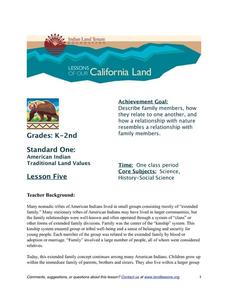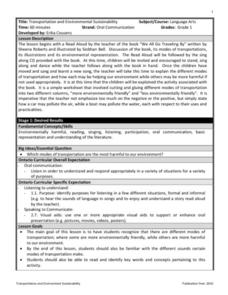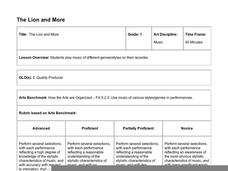Indian Land Tenure Foundation
Relationship with Nature
After a class discussion that focuses on kinship and extended family, young learners explore how Native Americans have lived in clans and other forms of extended family divisions. Pupils also see how Native Americans relate to the...
Curated OER
What’s your Name?
Youngsters work to build empathy, cultural understanding, and a sense of self as they uncover the story behind their own names. They read the book, The Name Jar, discuss immigration and how it feels to be in a new place. Then, they...
Curated OER
Transportation and Environmental Sustainability
After listening to the book, We All Go Traveling By, 1st graders discuss different modes of transportation that they see out in the world, and the environmental impacts of each one. Kids work together to create a list of the types of...
Personal Genetics Education Project
DNA, Crime and Law Enforcement
Civil rights meets biotechnology in a instructional activity that scrutinizes the collection of DNA of citizens who have been arrested, but not yet convicted of a crime. Real-life cases are examined in which the DNA of a relative was...
Personal Genetics Education Project
Direct-to-consumer Genetic Testing
If you knew that you were likely to develop Alzheimer's disease in your future, how would it affect your life in the meantime? This and other similar thought-provoking questions are discussed in a lesson plan about the availability of...
Curated OER
Partitioning a Hexagon
The task at hand is to partition a hexagon into two, four, and eight congruent figures. Make sure to give your wizards a sheet of triangle grid paper on which to decompose the hexagons. Have them explain which rotations, reflections, or...
Brooklyn Children’s Museum
Inside India
What can a Ganesh statue, hand ornament, and print block tell you about India? Introduce your learners to the geography, history, and culture of India by analyzing primary sources and using the well-designed worksheets provided in this...
Common Sense Media
Private Today, Public Tomorrow
What responsibility do we have to protect the privacy and safety of others when posting information about them online? This is an essential lesson for every learner today experiencing their social and professional worlds in an online...
Idaho State Department of Education
Lessons for Social Studies Educators
Point of view, purpose, and tone: three concepts readers of primary and secondary source materials must take into account when examining documents. Class members view a PowerPoint presentation and use the SOAPS strategy to identify an...
Dream of a Nation
Creating Awareness through Action Oriented Writing and Research
Middle schoolers aren't too young to feel strongly about politics, social issues, consumer rights, or environmental problems. Demonstrate the first steps toward social change with a project about action-oriented writing. Eighth graders...
UNICEF
Get Real on Climate
Climate change isn't just about a warming planet; it will affect humans' health, spread of disease, changes in heat waves and droughts, and changes in storms and wildfires. Participants explore global climate change through discussions...
Advocates for Human Rights
Nativism and Myths about Immigrants
Where do anti-immigrants myths come from, and how can they be refuted? Learners critically analyze media reports and how to identify reliable sources. After studying a timeline that details the history of US nativism, groups research the...
Media Education Lab
The Ethics of Propaganda
What are the short and long-term consequences for consumers and producers of modern media propaganda? Class members ponder this essential question as their unit study of ethics of propaganda concludes. After examining two case studies,...
Anti-Defamation League
Identity-Based Bullying
What is identity? What is bullying? What is identity-based bullying? After discussing these questions as a class, pupils engage in partner discussions before participating in a small group activity to act out bullying scenarios. Then,...
Cornell University
Non-Newtonian Fluids—How Slow Can You Go?
Children enjoy playing with silly putty, but it provides more than just fun. Young scientists make their own silly putty using different recipes. After a bit of fun, they test and graph the viscosity of each.
Smithsonian Institution
General George Washington, Military Leader
Teach pupils the characteristics that make George Washington such an effective leader, especially in context of his time period. Scholars view artifacts, participate in group work, create lists, compare and contrast, and discuss as a...
Hawaiʻi State Department of Education
The Lion and More
Melody, rhythm, tempo, and dynamics; get out those recorders it's time to play music! Your class will work on playing two lion-themed pieces that exemplify two different styles, folk and waltz. They'll discuss the elements of music and...
Roads to Success
Introduction to Team Building
What can working in a group trying to build the tallest tower possible using only tape and drinking straws get you? A great opportunity for developing collaborative team-building skills!
Curated OER
The Clique
Ninth graders identify and demonstrate the ability to use interpersonal skills needed to maintain quality relationships. Then they identify personal responsibility in conflict situations, while continuing to apply problem-solving and...
Indian Land Tenure Foundation
Relationships to Places
Young historians take a look at how the Indian tribes of California promoted a mindful relationship between people and the land. They begin to understand how the Indians were champions of conservation, and at preserving the natural...
Gustavus Adolphus University
Five Physical Fitness Components
Five learning stations for five physical fitness components: cardiovascular exercise, body composition, muscle endurance, muscular strength, and flexibility. As pupils progress through each station, they will complete assigned tasks,...
EngageNY
Construct and Apply a Sequence of Rigid Motions
Breaking the rules is one thing, proving it is another! Learners expand on their previous understanding of congruence and apply a mathematical definition to transformations. They perform and identify a sequence of transformations and use...
EngageNY
Conversion Between Celsius and Fahrenheit
Develop a formula based upon numerical computations. The 31st part of a 33-part unit has the class determine the formula to convert a temperature in Celsius to a temperature in Fahrenheit. They do this by making comparisons between the...
The Holler
Conflict Resolution
Does your class understand the importance of peaceful conflict resolution? Middle schoolers share conflict stories, then collaborate to resolve simulated conflicts during an engaging lesson plan. The teacher's guide contains...
Other popular searches
- Character Education Respect
- Bulletin Board Ideas Respect
- Respect Activities for Kids
- Guidance Lessons on Respect
- Respect Lesson Plans
- Teaching Respect
- Respect Activities
- Self Respect
- Respecting Authority
- Respect Personal Space
- Respect Authority
- Respect for Authority

























